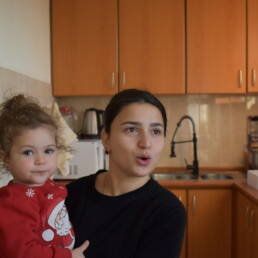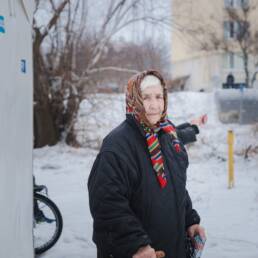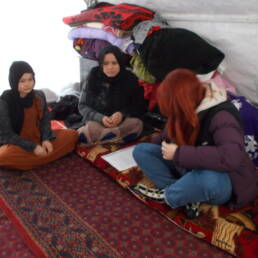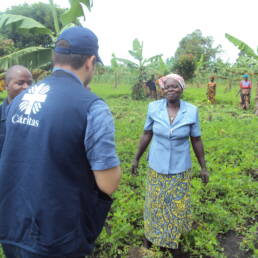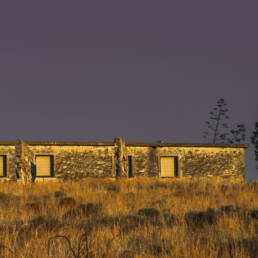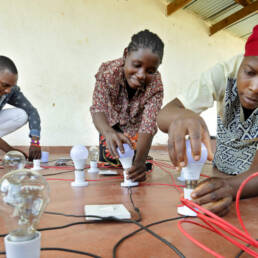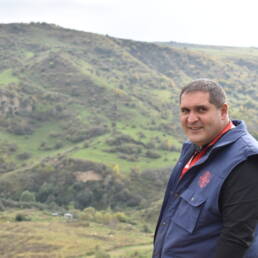Author
Thomas Hackl
Humanitarian Aid Programme Director
Caritas Romania
Maksym takes his job very seriously. He is responsible for the security of the Caritas Ukraine teams working in the buffer zone along the contact line with the non-government controlled areas (called by its leaders the “Donetsk People’s Republic” and the “Luhansk People’s Republic”) in eastern Ukraine.
Since 2014, this is an area of armed conflict in the middle of Europe. Hundreds of thousands of people have left the region during the last years, but many more still stay in the buffer zone. Even if officially there is a ceasefire, shelling and shootings between the Ukrainian army and the separatist forces on the other side of the contact line continue almost every day.
This time Maksym is responsible for our security – a group of representatives of European Caritas organisations, all members of the Caritas Europa Humanitarian Action Group. We were invited by Caritas Ukraine to get to know the area, the people living there and the work Caritas is doing to support the people living in the conflict zone.
Like all Caritas Ukraine staff working in the area, we have to wear body armors. Helmets are within reach in the cars. Maksym knows the security threats in the area; he is in permanent contact with the local authorities and the army. All staff working in the area is regularly trained on security issues and first aid, and they follow strict security protocols. Caring for security does not make the work of the Caritas teams easier (for example wearing heavy body armors all time when working in the area), but it saves lives.
Our first station is Maryinka, a little city just some hundreds of meters from the contact line between the Ukrainian and the non-government-controlled areas. Tamara, one of the beneficiaries of a Caritas programme expects us in front of the block of flats where she lives. The building was hit by bombs in 2016. Since, Tamara has been trying to repair her apartment with the support of Caritas.
“Now, during daytime, it is quiet, but in the evening the shooting and bombing will start again”, she tells us. At least, the armed groups on the other side of the frontline do not shell the city directly any more, as it happened in the first years of the conflict. But from time to time bombs and shells miss their targets and come down in the residential areas. 42 civilians have been killed in Maryinka during the last years, 120 injured.
Before the war, Tamara, like many other people from the area, worked in Donetsk, the big industrial center of the Donbass region in eastern Ukraine, just some kilometers from Maryinka. Today, she no longer has a job as Donetsk is on the other side of the frontline. Tamara, and many other people, depend on the support they receive from the government and on humanitarian aid, including food and heating materials.
In another area of Maryinka, we visit Halina (84 years old) and her daughter Ludmila (48). Their house is just 400 meters from the contact line. The two ladies are both disabled, making it very difficult for them to leave their house or to get to the cellar for protection. The house has been hit twice by shells, destroying the roof and the windows. Ludmila was injured in one of the attacks. They left Maryinka only for a short period in 2015/16 when the bombing was most serious, but soon they came back. Their pension of just 40 euros does not allow them to live anywhere else. With the support of Caritas, the house has been repaired and windows replaced, but Halina and Ludmila face also other problems: the drinking water in Maryinka is polluted by the former coal mines on the other side of the contact line. Now they use the water from their own dug-well, but nobody knows how safe it is.
Our next stop is in Krasnohorivka, another little town at the frontline. We visit the kindergarten where a social worker and a psychologist from Caritas organise regular psycho-social support programmes for the children. These children have spent most of their lives in war. They have had to listen to shootings and shelling, looking for shelter in the basements of the buildings where they live. People have been injured and killed in their surroundings. This kind of permanent stress affects their development and many of them suffer from speech disorders or have difficulties to express their emotions.
During our visit, they accompany a piece of music with different noises: some children use a straw to blow bubbles in a glass of water, two boys pour water from a watering can into a big bowl and a girl rings a bell. The social worker, sitting amid the children, gives them the cues and finally they produce a wonderful piece of art.
Nina, a Caritas staff member working in the area, explains the purpose of the programme: “We do these programs to reduce the stress and to create a connection between life in peace and the situation they live in”.
Meanwhile, the children return to their tables. They are painting with their fingers on mirrors – colourful flowers and landscapes. Between the shapes, their faces appear in the mirrors, some of them even smiling…
We leave the conflict zone, take off the protection vests and hand over the helmets to Maksym. Everybody from our group rushes to catch trains and planes to get back to their countries where people live in peace, most of them not even knowing what is going on in the east of their continent. But our colleagues from Caritas Ukraine will stay in the area to support the most vulnerable people survive these difficult times in dignity. It is up to us, those living in peace, to tell the story of these people and to support our colleagues in their work in this almost forgotten humanitarian crisis that is not at all far away from us.




